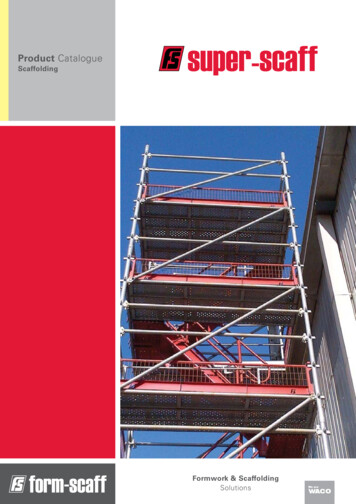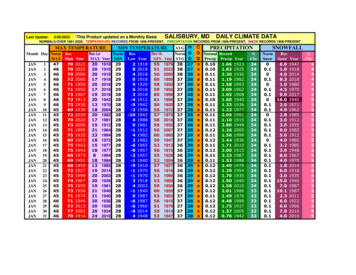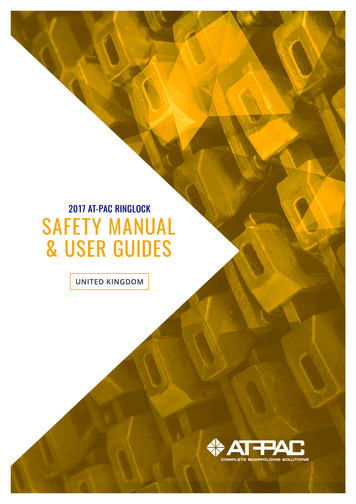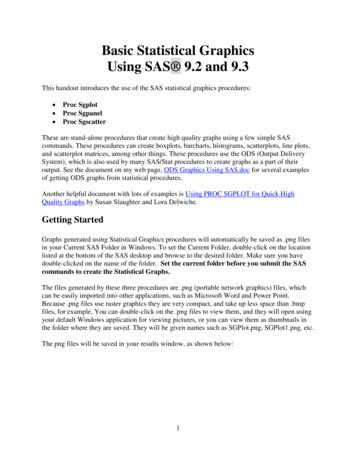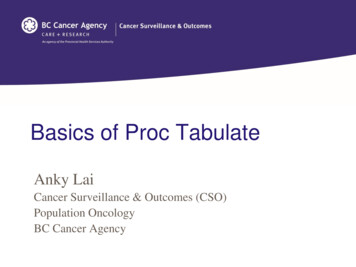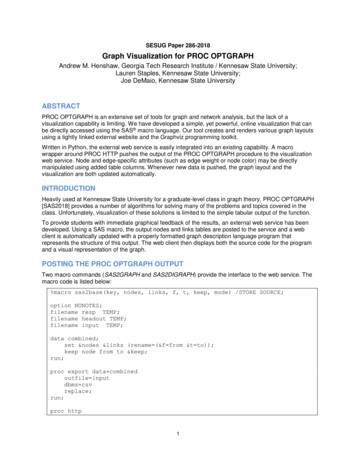
Transcription
RECOMMENDED SCAFFOLDING ERECTION PROCEDUREIntroductionThis guide has been prepared by the Scaffolding, Shoring &Forming Institute to assist contractors, architects, engineers, dealers, erectors, and users, etc., for the proper use of scaffoldingequipment. Scaffolding Safety Rules published by the Instituteshould be used in conjunction with this publication, as well as theinstructions for the use of scaffolding provided by the manufacturer.Safety precautions and requirements prescribed by local, state, andfederal agencies, including OSHA, must be followed at all times andpersons working with scaffolding systems should be equipped withrequisite safety 14.15.16.17.18.19.Accessories—Those items other than frames and bracesused to facilitate the construction of scaffolding towersand structures.Adjustment Screw—Device composed of a threadedscrew and an adjusting handle used for the verticaladjustment of the scaffolding.Base Plate—A device used to distribute the leg load.Climbing Ladders—A separate ladder attached to thescaffolding structure or built into the scaffold frame.Casters—Wheels of a suitable dimension and unit designed to attach to the base of a tower and containing abrake to prevent the wheels from rotating.Coupling Pin—Device used to align and connect lifts ortiers together vertically.Cross-bracing—System of members connecting framesor panels of scaffolding to make a tower structure.Extension Device—Any device used to obtain verticaladjustment of scaffolding other than an adjustment screw.Factor of Safety—the ratio of ultimate load to theallowable load.Frame or Panel —the principal prefabricated, weldedstructural unit.Guardrail-A rail secured to uprights and erected alongthe exposed sides and ends of platforms.Horizontal Diagonal Bracing—Diagonal braces running horizontally between frames of scaffolding.Lifts or Tiers —The number of frames stacked oneabove each other in a direction.Locking Device—A device used to secure the crossbrace to the panel.Putlog or Truss—A separate horizontal load carryingmember.Rolling Towers—A composite structure of frames,braces, platforms, guardrails, and accessories supportedby casters.Safe Leg Load—That load which can safely be directlyimposed on the frame leg.Safe Scaffold Frame Horizontal Member Load—That load which can safely be directly imposed on ahorizontal member.Scaffolding Layout—An engineered drawing preparedprior to erection showing arrangement of equipment forproper scaffolding use.20. Side Bracket—A cantilevered arm unit, supported bythe scaffolding frame.21. Sill or Mud Sill —A footing, usually wood, whichdistributes the vertical leg loads to the ground.22. Ties—A tension compression member used to securelyattach scaffold to a structure.23. Toeboard—A barrier secured along the sides and endsof a platform, to guard against the falling of material.24. Towers—A composite structure of frames, braces, andaccessories.25. Ultimate Load—The maximum load which may beplaced on the scaffolding causing failure by buckling ofcolumn members or yielding of some component. These terms can be used synonymously.Inspection of ScaffoldingEquipment Prior to ErectionThe three main areas of inspection are for corrosion,straightness of members and welds. This applies to allcomponents of a scaffolding system.1. CORROSION—Heavily rusted or eroded scaffoldingequipment is a telltale sign of abuse or neglect.2. STRAIGHTNESS OF MEMBERS—Mishandling,trucking and storing may cause damage to scaffoldingequipment. All scaffolding components should be straightand free from bends, kinks or dents.3. WELDS—Equipment should be checked before use fordamaged welds and any piece of equipment showingdamaged welds or rewelding beyond the original factoryweld should not be used. The factory weld referencepertains to location and quality of rewelds.While CORROSION, STRAIGHTNESS, and WELDSare of primary concern other component parts should bechecked.4. Locking devices on frames and braces shall be in goodworking order, and if not, must be repaired or replacedprior to use.5.Coupling pins must effectively align the frame or panellegs.6.Pivoted cross braces must have the center pivot securelyin place.7.Caster Brakes shall be in good working order and if notmust be repaired or replaced prior to use.Safe Bearing Loads for SoilsConsidering that the allowable loads (bearing) on varioussoils and rock range from less than 1,000 p.s.f. to more than50,000 p.s.f. care should be exercised in determining thecapacity of the soil for every scaffolding job, realizing thatweather conditions can turn an otherwise suitable groundcondition into a hazardous situation. As an example, dry claywith an allowable bearing capacity of 8,000 p.s.f. couldbecome very plastic after a rainfall and drop to less than 2,000p.s.f.PAGE 1 OF 4
Care should also be taken not to excessively disturb thesoil. If fill is required in areas where scaffolding is used, aqualified engineer should be consulted as to materials andcompaction.FoundationsThe purpose of a good foundation or mud sill is todistribute the scaffolding load over a suitable ground area.The size of the footing or sill is determined by the total loadcarried over a particular ground area, and by the nature of thesoil supporting these sills.The total load should be computed and the sills designedaccordingly.When scaffolding from earth or fill, the areas shouldbe leveled and the sills spaced in a pattern assuringadequate stability for all scaffolding legs.Erection of FramesThe work of erecting the scaffolding should be under thesupervision of a person with proper experience and aptitudefor securing a safe installation and who is familiar with allLocal, State and Federal Regulations concerning scaffolding,as well as the SSFI Scaffolding Safety Rules.It shall be the responsibility of the person supervising theerection of the scaffold to see that all components and lockingdevices are in working order, and no damaged or deterioratedequipment is used in the setup. Should any scaffoldingbecome damaged after the equipment has been erected,workmen shall not be allowed on same until the damageditems have been repaired or replaced.Advanced planning will help the erection of scaffoldingto progress smoothly. The equipment should be unloaded asclose to the area of use as possible and should be arranged inthe order it is to be used. Adjustment screws should be set totheir approximate final adjustment before setting up thescaffolding. At this time, a person should check to see that allpanels which require coupling pins have them. Consultsafety rules as recommended by the Institute.After erecting the first tier of scaffold frames, plumb andlevel (using instruments) all frames so that no matter howhigh the final scaffolding setup, the additional frames willalso be in correct alignment.As erection proceeds, securely tie all scaffolding to thestructure at the ends and at least every 30' horizontally, andat height intervals not to exceed* 4 times the minimum basedimension. Free standing scaffold towers must be restrainedfrom tipping by guying or other means. Scaffold frames mustbe fastened together at coupling pins where there is a possibility of uplift.When scaffolds are to be partially or fully enclosed,specific precautions must be taken to assure frequency adequacy of ties attaching the scaffolding to the building due toincreased load conditions resulting from effects of wind andweather. The scaffolding components to which the ties areattached must also be checked for additional loads.When erecting additional lifts, always work from planking placed within the scaffold structure. Move planking aserection progresses.Planking and AccessoriesUse only lumber that is properly inspected and graded foruse as scaffold plank.Planking shall have at least 12" of overlap and extend 6"beyond center of support or be cleated at both ends to preventsliding off support. Do not allow unsupported ends of plankto extend beyond supports. Secure plank to scaffolding whennecessary.All scaffold accessories shall be used and installed inaccordance with the manufacturer's recommended procedures. Accessories shall not be altered in the field.When installing hanger or clamp supported putlogs(trusses), care should be taken to see that they extend at least6" beyond the point of support. Also, make sure that theproper bracing is placed between putlogs (trusses). When thespan between supporting members is more than 12' additional bracing between the putlogs (trusses) and the supporting member may be required. Do not cantilever or extendputlogs (trusses) as side brackets without thorough consideration for loads to be applied or transmitted to the scaffold.When clamping putlogs, clamp capacity may control ratherthan putlog capacity. Consult scaffold manufacturer.All brackets should be seated correctly with side brackets parallel to the frames and the end brackets at 90 degreesto the frame. Brackets shall not be bent or twisted fromnormal position.Equip all planked or staged areas with proper guard railsand add toeboards when required.Final and Daily Inspection of ErectedScaffoldingThe following is a list of check points to be covered whenmaking a final and daily inspection of scaffolding prior touse. All points should be carefully checked to insure a safeand accident-free job and be periodically rechecked.1. Check to see that there is proper support under every legof every frame on the job. Check also for possiblewashout due to rain.2. Check to make certain that all base plates and adjustmentscrews are in firm contact with their supports. Alladjustment nuts should be snug against the legs of theframe.3. Frames should be checked for plumbness in both directions.4. If there is a gap between the lower end of one frame andthe upper end of another frame it indicates that oneadjustment screw must be adjusted to bring the frames incontact. If this does not help it indicates the frame is outof square and should be replaced.5. Each leg of each frame should be cross braced to thecorresponding leg of the next frame.6. While checking the cross braces also check the lockingdevices to assure that they are all in their closed positionor that they are all tight.7. Check to be certain that all planking and accessories areproperly installed.8. Check to make certain all ties are secured between thestructure and the scaffolding.PAGE 2 OF 4
9. Check to be certain all guard rails are in place.10. If scaffolding is enclosed, check to see that additionalprecautions have been taken as noted in Section ofErection. Recheck periodically ties, clamps, etc., formovement.11. Insure that safe access to work platform(s) is provided.Dismantling of ScaffoldingThe work of dismantling scaffolding should be under thesupervision of an individual with proper experience andaptitude. The following should be observed while dismantling.1. Check to see if scaffolding has been structurally alteredin any way which would make it unsafe, and if soreconstruct where necessary before commencing withthe dismantling procedures.2. Dismantle scaffold from the top down. Begin by removing all accessories from that lift being dismantled at thetime.3. Always work from a minimum of two plank placed on thetier of frames below those being removed. Move theplanking down as dismantling progresses.4. Do not remove ties until dismantling has reached the tierto which they are attached.5. Always stay within the inside of the scaffold. Do notclimb on the outside for any reason when dismantling.Do not climb on ties, braces or unbraced frames.6. Only remove fastening devices from bottom of framesbeing removed.7. Lower scaffolding components in a safe manner as theyare dismantled. Avoid dropping or throwing the components as this could result in damage to the equipment, orinjury to personnel below.Erection of Rolling TowersWhen erecting rolling scaffolding towers, the followingadditional items apply. These items are in addition to theapplication portions of the preceding section.1. Caster should be of adequate load capacity and size inrelation to the height of the tower, the surface over whichthe tower is to be used and in accordance with allgovernment, state, and local codes, ordinances, and regulations.Casters with plain stems shall be attached to the panel oradjustment screw by pins or other suitable means.2. Do not extend adjusting screws on rolling towers morethan 12".3. The platform height shall not exceed* four (4) times thesmallest base dimension unless guyed or otherwise stabilized.4. Horizontal diagonal braces should be used near thebottom, top and at 20' intervals measured from the rollingsurface.5. When side brackets are used, consideration should begiven to the overturning effect these brackets will haveupon the stability of the tower.6. Cross brace every lift-both sides.7. Install guardrails.Printed in the U.S.A.8. Plank according to Plank and Accessories Section ofErection Procedure.* EXCEPTIONS: Three times in California, Ohio, Oregon,Montana, Maine; 3-1/2 times in Washington.Final Inspection of Rolling TowersThe following additional points should be checked whenmaking a final inspection of rolling scaffold towers prior totheir use. These points are in addition to the applicable itemscovered under the preceding section entitled, "Final Inspection of Erected Scaffolding."1. Check to see that the platform height does not exceed*four (4) times the smallest base dimension unless thetower is properly guyed or otherwise stabilized.2. Check to see that, if adjusting screws have been used,they are not extended more than 12".3. Check to make sure the caster brakes are in good workingcondition and are applied when tower is not being moved.4. Inspect to make sure horizontal diagonal bracing hasbeen placed near the bottom, top, and at 20' intervalsmeasured from the rolling surface. A hook on manufactured platform properly attached to the top frame may beequivalent to the top horizontal diagonal brace.5. Cross bracing has been installed on both sides of everylift.6. Check the area in which the tower is to be used to insurethere are no obstructions either in, on, or above the floorwhich will interfere with the proper and safe use of therolling tower.7. Check for guardrails.8. Check to see that all planks and fabricated platforms areproperly installed.9. Insure that safe access to work platform(s) is provided.REFER TO SCAFFOLDING, SHORING & FORMINGINSTITUTE SCAFFOLDING SAFETY RULES BEFOREUSING SCAFFOLDING.The procedures outlined in this Guide describe conventionalprocedures for erecting and dismantling scaffolding systems.However, equipment and systems differ and, accordingly,reference must always be made to the instructions and procedures of the manufacturer or supplier of the equipment. Sincefield conditions vary and are beyond the control of theInstitute and its members, safe and proper use of this equipment is the responsibility of the user and not the Institute orits members.SCAFFOLDING AND SHORING INSTITUTE1230 KEITH BUILDINGCLEVELAND, OHIO 44115125 TAYLOR PARKWAYARCHBOLD, OHIO 43502 Bil-Jax, Inc. 2004PAGE 3 OF 4FORM NO. SSI-83-80-68
SCAFFOLDING SAFETY GUIDELINESas Recommended by SCAFFOLDING, SHORING & FORMING INSTITUTEIt shall be the responsibility of all employers and employees to read and comply with the following common sense guidelines which are designedto promote safety in the erecting and dismantling of scaffolds. These guidelines do not purport to be all-inclusive nor to supplant or replace otheradditional safety and precautionary measures to cover usual or unusual conditions. Local, State or Federal statute or regulations shall supersedethese guidelines if there is a conflict and it is the responsibility of each employee to comply.GENERAL GUIDELINESI. POST THESE SCAFFOLDING SAFETY GUIDELINES in a conspicuous place and be sure that all persons who erect, dismantle or use scaffolding are awareof them.II. FOLLOW ALL STATE, LOCAL AND FEDERAL CODES, ORDINANCES AND REGULATIONS pertaining to scaffolding because they may be morerestrictive. For example, height or width requirements may vary.III. SURVEY THE JOB SITE—A survey shall be made of the job site for hazards, such as untamped earth fills, ditches, debris, high tension wires, unguardedopenings, and other hazardous conditions created by other trades. These conditions shall be corrected or avoided as noted in the following sections.IV. INSPECT ALL EQUIPMENT BEFORE USING—Never use any equipment that is damaged or defective in any way.V. KEEP ALL EQUIPMENT IN GOOD REPAIR—Avoid using corroded equipment—the strength of corroded equipment is not known.VI. INSPECT ERECTED SCAFFOLDS DAILY—or at the beginning of every shift to be sure that they are maintained in safe condition.VII. NEVER USE EQUIPMENT FOR PURPOSES OR IN WAYS FOR WHICH IT WAS NOT INTENDED.VIII. REPORT ANY UNSAFE CONDITION. NEVER TAKE CHANCES—Do not work on scaffolds if your physical condition is such that you feel dizzy orunsteady in any way.IX. WORKING UNDER THE INFLUENCE OF ALCOHOL OR ILLEGAL DRUGS IS STRICTLY PROHIBITED.X. CONSULT YOUR SCAFFOLDING SUPPLIER—NEVER TAKE CHANCES—Consult manuals and instructions provided by the supplier; scaffolding ishis business.GUIDELINES FOR ERECTION AND USE OF SCAFFOLDSA. PROVIDE ADEQUATE SILLS for scaffold posts and use base plates.P. FOR ROLLING SCAFFOLDS THE FOLLOWING ADDITIONAL GUIDELINES APPLY.B. USE ADJUSTING SCREWS for other approved conditions.1. CASTERS WITH PLAIN STEMS shall be attached to the panel or adjustC. PLUMB AND LEVEL ALL SCAFFOLDS as the erection proceeds. Do not forcement screw by pins or other suitable means.braces to fit—level the scaffold until proper fit can be made easily.2. DO NOT EXTEND ADJUSTING SCREWS ON ROLLING SCAFFOLDSD. BRACING. Each frame or panel shall be braced by horizontal bracing, crossMORE THAN 12 INCHES.bracing, diagonal bracing or any combination thereof for securing vertical3. WHEELS OR CASTERS shall be provided with a locking device and keptmembers together laterally. All brace connections shall be made secure, inlocked during erection and dismantling or any time scaffolds are not beingaccordance with manufacturers' recommendations.moved.E. DO NOT CLIMB CROSS BRACES. Use only an access (climbing) ladder,4. SECURE OR REMOVE ALL MATERIAL AND EQUIPMENT fromaccess steps, frame designed to be climbed or equivalent safe access to scaffold.platform before moving scaffold.F. TIE RUNNING SCAFFOLD TO WALL or structure when the height exceeds*5. USE HORIZONTAL DIAGONAL BRACING near the bottom and at 20 footfour (4) times the minimum scaffold base dimension. The first vertical andintervals measured from the rolling surface.longitudinal tie shall be placed at this point. Vertical ties shall be repeated atintervals not greater than 26 feet. Longitudinal ties shall be placed at each end6. DO NOT USE brackets or other platform extensions without considerationand at intervals not greater than 30 feet. Ties must prevent the scaffold fromof overturning effect.tipping into or away from the wall or structure.7. THE HEIGHT OF A ROLLING SCAFFOLD excluding its uppermostG. WHEN SCAFFOLDS ARE TO BE PARTIALLY OR FULLY ENCLOSED,guardrails, must not exceed* four times its smallest base dimension unlessspecific precautions must be taken to assure frequency and adequacy of tiesit is stabilized by an engineered counterweight system or some otherattaching the scaffolding to the building due to increased load conditionsequivalent means.resulting from effects of wind and weather. The scaffolding components to which8. CLEAT OR SECURE ALL PLANKS.the ties are attached must also be checked for additional loads.9. DO NOT ATTEMPT TO MOVE A ROLLING SCAFFOLD WITHOUTH. WHEN FREE STANDING SCAFFOLD TOWERS exceed* four times theirSUFFICIENT HELP—watch out for holes in floor and overhead obstrucminimum base dimension vertically, they must be restrained from tipping.tions—stabilize against tipping.I. DO NOT ERECT SCAFFOLDS NEAR ELECTRICAL POWER LINES UN10. DO NOT RIDE ROLLING SCAFFOLDS.LESS PROPER PRECAUTIONS ARE TAKEN. Consult the power service11. JOINTS shall be restrained from separation.company for advice.Q. FOR "PUTLOGS" AND "TRUSSES" the following additional guidelines apply.J. DO NOT USE ladders or makeshift devices on top of scaffolds to increase the1. DO NOT CANTILEVER OR EXTEND PUTLOGS/TRUSSES as sideheight.brackets without thorough consideration for loads to be applied.K. DO NOT EXCEED MANUFACTURERS' RECOMMENDED LOAD RAT2.PUTLOGS/TRUSSES SHOULD BE EXTENDED AT LEAST 6 inchesING.beyond point of support.L. EQUIP AND MAINTAIN ALL PLATFORMS with proper guardrails, mid-rails,3. PLACE RECOMMENDED BRACING BETWEEN PUTLOGS/TRUSSESand toeboards along all open sides and ends of scaffold platforms.when the span of putlog/truss is more than 12 feet.M. ALL BRACKETS shall be seated correctly with side brackets parallel to theframes and end brackets at 90 degrees to the frames. Brackets shall not be bent R. WHEN DISMANTLING SCAFFOLDING THE FOLLOWING ADDITIONALGUIDELINES APPLY:or twisted from normal position. Brackets (except mobile brackets designed to1. CHECK TO SEE IF SCAFFOLDING HAS BEEN STRUCTURALLYcarry materials) are to be used as work platforms only and shall not be used forALTERED in any way which would make it unsafe, and if so, reconstructstorage of material or equipment. When brackets are used, the scaffold shall bewhere necessary before commencing with dismantling procedures.tied to the structure or otherwise restrained to prevent tipping.2. VISUALLY INSPECT PLANK prior to dismantling to be sure that they areN. ALL SCAFFOLDING ACCESSORIES shall be used and installed in accordancesafe to work on.with the manufacturers' recommended procedure. Accessories shall not be3. COMPONENTS SHOULD BE LOWERED as soon as dismantled in safealtered in the field. Scaffolds, frames and their components of various manufacmanner so as to protect personnel below.turers shall not be intermixed.4. DO NOT ACCUMULATE EXCESS COMPONENTS OR EQUIPMENTO. FOR PLANKING, THE FOLLOWING GUIDELINES APPLY:on the level being dismantled.1. Use only lumber that is properly inspected and graded as scaffold plank.5.DISMANTLED EQUIPMENT should be stockpiled in an orderly manner.2. Planking shall have at least 12 inches of overlap and extend 6 inches beyondcenter of support, or, be cleated at both ends to prevent sliding off supports. S. FOLLOW ERECTION PROCEDURES AND USE MANUALS.3. Fabricated scaffold planks and platforms, unless created or restrained byhooks, shall extend over their end supports not less than 6 inches nor more * EXCEPTIONS: Three times in California, Ohio, Oregon, Montana, Maine; 3-1/2than 12 inches.times in Washington.4. Secure plank to scaffold when necessary."These safety guidelines set forth common sense procedures for safely erecting and dismantling scaffolding equipment. However, equipment and scaffoldingsystems differ, and accordingly, reference must always be made to the instructions and procedures of the supplier of the equipment. Since field conditions vary andare beyond the control of the Institute, safe and proper use of scaffolding is the responsibility of the user and not the Institute."Reprinting of this publication does not imply approval of product by the Institute or indicate membership in the Institute. Permission to reproduce in entirety canbe obtained from Scaffolding, Shoring & Forming Institute, 1230 Keith Bldg., Cleveland, Ohio 44115FORM NO. 3-61/4-89Printed in the U.S.A.PAGE 4 OF 4
INSTRUCTIONS FOR ERECTINGROLLING OR STATIONARY TOWERSBil-Jax, Inc. recommends that all users of this equipment be supplied with safetyinformation and OSHA rules and regulations. This information must be thoroughlyread and understood before using the equipment. If you have not been providedwith OSHA regulations or safety literature, please call 419/445-8915 before use.GUARD RAIL& POSTSSTEELTOEBOARDSTEPFRAMEBil-Jax Rolling Towersoffer large work platformareas and adjustable platform levels, while providing workers with a quick,easy and safe assembly.INSERT CORNERSQUARINGBRACEA Rolling Tower shouldonly be used on solid, leveland clear floor areas. Donot use on soil or unlevelsurfaces. Check for overhead obstructions whichmay interfere with thetower.CASTERNOTE: Some areas may require separate access ladders orstairs. Consult your local authorities for information before beginning scaffold erection.WARNINGMetal conducts electricity. Do notuse this equipment in areas wherecontact may be made with powerlines or other live electrical circuits.Failure to comply with the precedingwarning will result in serious personal injury or death.AII0202-02531. Before starting scaffold erection, check all parts for damage, making sure that they are inproper working order. Any part that does not look to be in good working condition or isdamaged in any way should not be used.PAGE 1 OF 4
BRACING2. Attach diagonal bracing to framesections, securing in place withthe frame brace locks (Fig. 1).Fig. 1J-LOCK (Standardw/Notched Braces)Fig. 3CASTERS, JACKS, BASE PLATESFig. 2StemRetainerClamp3. Insert casters and secure with attachingpin or bolt. Set brakes on all casters(Fig. 2) before proceeding with towererection. If leveling casters or extensions are used, secure with stem retainer clamp, wire, or other suitablemeans (Fig. 3). Do not extend levelingscrews more than 12". If applicationdoes not call for a Rolling Tower, followabove procedure and replace casterswith leveling jacks (Fig. 4) or base plates(Fig. 5) on mud sills.AttachingPinFig. 4LevelingJackFig. 5RigidSwivelCAT-A-CORNER SQUARING BRACE4. Install cat-a-corner squaring brace (thisshould be installed at the base andevery additional 20' of height).PAGE 2 OF 4
OUTRIGGERS5. Determine tower height required to complete the job. If height exceeds 3 timesthe minimum base dimension, (see FreeStanding Tower Height section below)install outriggers to increase minimumbase dimension or tie in to permanentstructure as codes require. Pin caster tooutrigger and attach outrigger to scaffoldleg. Adjust to desired angle and tightenclamp firmly to prevent movement. Setcaster brakes.1 outrigger oneach tower cornerBil-Jax, Inc. recommends the maximum free-standingtower height permitted for a Rolling Tower be 3 times theminimum base dimension, although OSHA codes allow4 to 1 in most states. Consult your state and local codesto insure your tower complies with all applicable regulations.Some bracing hasbeen omitted in thisillustration for clarity.B. A.BaseDimensionx3(some statesallow 3-1/2or 4—checkyour local &state codes) B(maximumtower heightpermitted)(use smallest of the base dimensions)ADDING FRAME SECTIONS6. Hoist end frames and braces to next level by means of ropeand tag line. Install diagonal bracing. Secure frames togetherusing inserts and insert locking pins. Be sure to erect stepframes so that the steps continue above one another on thesame side of the frame. Full decking should be installed oncompleted tier before attempting to assemble next tier, andshould be moved up as each additional tier is completed.NOTE: When required, access ladder or stair sections must beinstalled at the same time as each scaffold section is added.All photos and drawings are for illustration only. Always concerned with the improvement of the quality of this product, the manufacturer reserves the right to modify specifications without prior notice. Followall applicable ANSI and OSHA Codes and Regulations for use of this equipment. Do not use this product in areas where user can come in contact with live power.PAGE 3 OF 4
GUARD RAILING - FINAL DECKING7. Upon completion of tower to desired height, installand lock double guard railing and toeboards on all4 sides as required by OSHA. Make sure all guardrail posts are secured with lock pins. Install walkboards to fully deck platform work area. Securewalkboards in place by using an 8 penny nail (Fig.6), engaging slide lock (Fig. 7), engaging rotationlock (Fig. 8), as equipped. See OSHA regulationsfor additional information concerning securingdecking.Fig. 6Fig. 7Fig. 8IMPORTANT: CAUTION Inspect scaffold daily or before each use. Do not exert horizontal force from on top of a freestanding scaffold. Do not climb or stand on cross braces or horizontalbraces. Do not swing around corner of scaffold to enterplatform from the cross brace side. Do not use boxes, ladders, or other means to increase working height. Do not stand or sit on guard rails. Do not use bricks, boxes, concrete blocks, or anyother unstable objects under scaffold leg. NEVER ride a moving scaffold. Do not move scaffold by applying a pulling or pushingforce at or near the top.NOTE: All OSHA , state and local codes and regulationspertaining to this equipment should be obtained, read, andthoroughly understood before attempting to erect or use thisequipment. Persons under the influence of drugs, alcohol, orprescription medication should not be on or near this equipment.Common sense should be implemented at all times during theerection and use of this equipment. DO NOT USE THISEQUIPMENT IN AREAS WHERE EQUIPMENT OR USERMAY COME IN CONTACT WITH LIVE POWER SOURCE. Do not use braces as a platform support. Do not use personnel brackets (side brackets) on aRolling Tower. Use approved access ladder or stairs to climb scaffold. Properly erected step type end frames willprovide "equivalent, safe access" as required byOSHA. When hoisting material or using side brackets, scaffold must be restrained from tipping by guying, tyingto a permanent structure or other acceptable means. Restrict loading to safe working loads. If unsure ofsafe load limit, consult your scaffold dealer. If you have not been provided with OSHA regulations or safety literature, or for any questions concerning the safe use of this equip
components of a scaffolding system. 1. CORROSION—Heavily rusted or eroded scaffolding equipment is a telltale sign of abuse or neglect. 2. STRAIGHTNESS OF MEMBERS—Mishandling, trucking and storing may cause damage to scaffolding equipment. All scaffolding components should be straight and free from bends, kinks or dents. 3.

